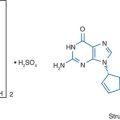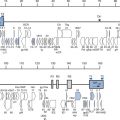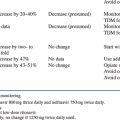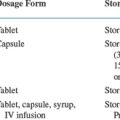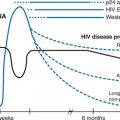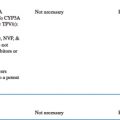Chapter 29 Pharmacogenetics of Antiretroviral Agents
INTRODUCTION
There is marked interindividual variation in plasma levels, efficacy, and in susceptibility to adverse effects of antiretroviral drugs (ART). Variable drug response likely reflects the combined influence of gender, environment, disease, concurrent drugs, and genetics. In this regard, genetic variation in the genes that encode for proteins involved in the metabolism or disposition of antiretroviral drugs is a key determinant of efficacy and toxicity to HIV drugs. Drugs such as protease inhibitors (PIs) and non-nucleoside reverse transcriptase inhibitors (NNRTIs), are extensively metabolized by cytochrome P450 enzymes such as CYP3A4, CYP2C19, CYP2D6, and CYP2B6.1,2 In addition, most PIs have been shown to be substrates of the efflux transporter P-glycoprotein, and of other cellular transporters.3 In the section under the heading of pharmacogenetics, the influence of genetic variation in genes involved in antiretroviral drug disposition on the pharmacokinetic and pharmacodynamic of antiretroviral agents will be discussed.
PHARMACOGENETICS OF ANTIRETROVIRAL AGENTS
CYP450 Metabolism
Drug metabolizing reactions are grouped into two phases; phase I reactions involve changes such as oxidation, reduction, and hydrolysis and are primarily mediated by the cytochrome P450 (CYP) family of enzymes highly expressed in organs such as the liver and intestine. Phase II reactions typically use an endogenous compound, such as glucuronic acid, glutathione or sulfate for conjugation to the drug or its phase I derived metabolite to produce a more polar product that can be excreted. Although genetic polymorphisms of phase II enzymes are well described and have been associated with disease states such as cancer,4 they are less likely to be a major pathway for the disposition HIV drugs.5 Accordingly, this section will focus mainly on variations in CYP enzyme-mediated metabolism and their impact on the disposition of antiretroviral drugs.
CYP3A
Enzymes of the CYP3A subfamily are the most abundantly expressed isoforms in the liver, comprising 25–40% of total hepatic P450 content6 and thought to account for most of the monooxygenase activity present in the gastrointestinal tract.7 Expression of CYP3A in the enterocyte of the small intestine and the liver accounts for the marked first-pass effect often observed following oral administration of its substrates. Because of its broad substrate specificity, CYP3A is involved in the metabolism of over 50% of currently used therapeutic agents, including most PIs and NNRTIs.8 In addition to being substrates for CYP3A, most PIs are inhibitors of CYP3A4 whereas NNRTIs induce CYP3A4.
CYP3A5-mediated metabolism has wide interindividual variability reflective of both environmental factors such as drug interactions involving inhibition and induction9,10 and genetic components.11 Not surprisingly, a number of laboratories have looked for single nucleotide polymorphisms (SNPs) in the coding and noncoding regions of both CYP3A4 and CYP3A5. Most of these appear to be uncommon (frequency <1–2%) and/or distributed to specific populations.12 A 2392A>G transition in the 5′-regulatory region of CYP3A4 (i.e., CYP3A4*1B) occurs more frequently, particularly among those of African descent.13 With CYP3A5, an A>G substitution within intron 3 (i.e., CYP3A5*3) a variant forming a truncated inactive protein is noted to be present in most subjects.14 A rarer G>A transition in exon 7 (i.e., CYP3A5*6) also results in a splicing defect. It has been suggested that these variants may contribute to the observed interindividual variability in CYP3A activity. Several studies have been performed in order to evaluate the effect of genetic variations in CYP3A4 on the pharmacokinetics of nelfinavir,15–17 efavirenz,15–18 and saquinavir19,20 (Table 29-1). These studies indicate that CYP3A4*1B, CYP3A5*3, and CYP3A5*6 have no influence on nelfinavir and efavirenz pharmacokinetics. CYP3A5*3 polymorphism has been associated with the urinary metabolic ratio of saquinavir to its hydroxy metabolites in healthy individuals. The mean metabolic ratio was significantly lower and the clearance was higher in subjects with active CYP3A5 compared to individuals with a functionally inactive enzyme.19,20
Table 29-1 Inherited Differences in the Metabolism of Antiretroviral drugs
| Gene or Protein† | Allele or Variant Evaluated | Reported Consequence for Antiretroviral Drugs |
|---|---|---|
| CYP3A4/A5 | CYP3A4*1B (-392A>G, promoter), and CYP3A4*18 (878T>C, L293P, altered activity). CYP3A5*3 (6986A>G, splice defect, severely reduced enzyme activity), and CYP3A5*6 (14690G>A, splice defect) | Possible effect on efavirenz for CYP3A4*1B and CYP3A5*3 (trend to higher AUC). No effect reported for nelfinavir. Saquinavir: metabolite ratio is lower for CYP3A5*3. |
| CYP2C19 | CYP2C19*2 (681G>A, aberrant splice site, truncated protein, poor metabolizer) | Nelfinavir: possible trend towards higher AUC and less virologic failure. No effect reported for efavirenz. |
| CYP2D6 | CYP2D6*3 (2549A>del, frameshift), CYP2D6*4 (1846G>A, splice defect), CYP2D6*6 (1707T>del, frameshift) | Nelfinavir: possible trend to higher plasma drug levels. Efavirenz: possible trend to higher plasma drug levels. |
| CYP2B6 | CYP2B6*5 (1459C>T, R487C), CYP2B6*6 516TG>T, Q172H, diminished function). Additional decreased-function alleles explain extreme elevation of efavirenz plasma levels | Geometric mean of efavirenz plasma AUC is 2.3-fold higher in individuals homozygous for the CYP2B6*6 allele. Associated with increased neuropsychological toxicity. 2B6*6 allele also influences nevirapine plasma levels. |
† See http://www.imm.ki.se/CYP alleles/for detail description of CYP alleles,135 http://www.hiv-pharmacogenomics.org for updated information for genetic influences on antiretroviral drugs.133
CYP2C19
CYP2C19 is important in the metabolism of the PI nelfinavir. Several loss of function genetic variants exist, two variants (CYP2C19*2 and CYP2C19*3) accounting for more than 95% of poor metabolizer phenotypes. Genotypic differences are observed among populations since 2–3% of Caucasians and 4% of Africans have the poor metabolizer phenotype versus 10–25% of Asians.21 A recent study demonstrated that nelfinavir exposure was significantly higher in treatment-naive HIV patients with GA or AA genotypes at position 681 in CYP2C19 (i.e., CYP2C19*2) compared to the wild type.17 This same study showed a trend toward decreased virologic failure in subjects with the GA genotype (Table 29-1).
CYP2D6
The CYP2D6 genetic polymorphism was originally discovered as a result of differences in the pharmacokinetics and therapeutic effects of drugs metabolized by this enzyme such as codeine, dextromethorphan, metoprolol, nortriptyline, and debrisoquin.22 Approximately 5–10% of Caucasian subjects were found to have a deficiency in their ability to oxidize the antihypertensive drug debrisoquin.23 Subjects with poor metabolism tend to be homozygous for mutations in CYP2D6 associated with marked loss or complete absence of enzymatic activity. However, it should also be noted that some subjects have multiple copies of CYP2D6 resulting in an extensive metabolizer phenotype.24 A study published by Fellay et al15 analyzed the association between CYP2D6*3, *4, and *6, representing the most frequent inactivating mutations in Caucasians leading to a poor metabolizer phenotype, and plasma levels of nelfinavir and efavirenz in treatment-naive HIV-infected patients. Patients homozygous or heterozygous for a loss of function CYP2D6 allele had a higher median plasma concentration of both nelfinavir and efavirenz when compared to patients with a CYP2D6 extensive meta-bolizer genotype (Table 29-1).
CYP2B6
CYP2B6 was thought to be expressed at low levels and only in a fraction of human liver samples. However, CYP2B6 has gained more attention since it was shown to be significantly involved in the metabolic activation and inactivation of a number of clinically important drugs such as efavirenz.25 A large interindividual variability in the hepatic content of CYP2B6 has been reported26 as well as functional differences between genetic variants.27 A number of studies have investigated for a possible role of genetic differences in CYP2B6 as the basis for toxicity to the NNRTI efavirenz. The relationship between efavirenz pharmacokinetics, central nervous system (CNS) side effects, weight, race, and virologic response was investigated in 154 HIV-infected individuals randomized to receive efavirenz-containing regimen.18 The authors found that a 516G>T polymorphism in exon 4 of CYP2B6 (i.e., CYP2B6*6) was more common in African-Americans compared with Caucasians. Furthermore, efavirenz AUC was three times higher in patients with the 516 TT genotype compared to GG homozygotes or GT heterozygotes. CYP2B6 516 TT genotype was also significantly associated with increased CNS side effects during the first week of efavirenz therapy. No association was observed between the allelic variants and virologic response. A number of studies have confirmed a role for the 516G>T polymorphism for efavirenz28–31 and nevirapine (Table 29-1).28
Induction of Drug Metabolizing Enzymes
In addition to genetic variations, expressed levels of CYP enzymes and drug transporters can be modulated by activation of certain nuclear receptors such as the Pregnane X Receptor (PXR).32 In organs such as the liver, these adopted orphan receptors mediate transcriptional activation of target genes by their ability to translocate into the nucleus once activated by ligands, which include a number of HIV drugs. In the nucleus, activated receptors then heterodimerize with the 9-cis retinoic acid receptor (RXR) and bind to response elements of target genes which then initiate target gene transcription.33 PXR has been shown to be a key factor responsible for CYP3A4, 2B6, and 2C9 transcriptional activation34–37 as well as for the efflux transporter MDR1.38 Of importance, it is now known that most PIs and certain NNRTIs act as PXR ligands leading to the induction of a number of phase I and II metabolic pathways. Therefore, it is not surprising that the combination of several PIs with or without NNRTIs often result in complex drug interactions. Unlike CYP enzymes, genetic variations in nuclear receptors such as PXR are rare.
Transporter Genes
Drug transporters expressed in tissues such as the intestine, liver, kidney, and brain play an important role in the absorption, distribution, and excretion of many drugs in clinical use. There are two major types of drug transporters: uptake and efflux transporters. Uptake transporters act by facilitating the translocation of drugs into cells, whereas efflux transporters function to export drugs from the intracellular to the extracellular milieu. Most efflux transporters tend to be members of the adenosine triphosphate (ATP)-binding cassette (ABC) superfamily of proteins that use energy derived from ATP hydrolysis to mediate substrate translocation across biologic membranes. Included in this class of transporters are multidrug resistance protein 1 (MDR1), the multidrug resistance-associated protein (MRP) family, and the breast cancer resistance protein (BCRP). There is now increasing evidence to suggest genetic heterogeneity in drug transporters not only contribute to the observed interindividual variation in drug disposition, but also to the drug response. Numerous polymorphisms have been identified in transporters important to drug disposition.39
MDR1 (ABCB1)
P-gp was first isolated from colchicine-resistant Chinese hamster ovary cells.40 Subsequently, the gene coding for P-gp (MDR1) was identified because of its over-expression in tumor cells associated with an acquired cross-resistance to multiple cytotoxic anticancer agents.41 This drug transporter was also recognized to be expressed in many normal tissues.42 P-gp is found on the canalicular domain of hepatocytes, the apical surface of proximal tubular cells in the kidney, the brush border surface of enterocytes, the epithelium of the brain choroid plexus as well as the luminal surface of blood capillaries in the brain, the placenta, the ovaries, the testes and, of relevance to HIV therapy, in CD56+, CD8+, and CD4+ lymphocytes.42–44 The function and tissue expression pattern for P-gp suggest that this transporter acts as a protective barrier to keep toxins out through excretion of substrate compounds into bile, urine, and the intestinal lumen and thereby limit the accumulation of such toxins or xenobiotics in organs such as the brain, gonads, and bone marrow, or in the fetus. P-gp is co-localized with the drug metabolizing enzyme CYP3A4 in the small intestine and liver suggesting that the extent of interplay between P-gp and CYP3A4 likely account for the net absorption and elimination of shared substrate drugs. Expression of P-gp at the level of the blood–brain barrier has shown to be critical to limiting the CNS entry of many drugs. Supportive evidence was obtained from animal models. A mouse strain naturally deficient in mdr1a, demonstrated marked sensitivity to the neurotoxic effects of ivermectin, an antiparasiticide substrate of P-gp.45,46 The absence of P-gp in the blood–brain barrier of such mice resulted in a more than 80-fold higher brain accumulation of ivermectin.45 Additionally, P-gp can alter oral drug absorption47 or enhance their biliary and renal excretion.48 P-gp has been shown to be particularly relevant to HIV therapy as PIs have been shown to be substrates of this transporter.49
Screening of the entire MDR1 coding region identified a synonymous SNP in exon 26 (i.e., 3435C>T) associated with altered protein expression although the SNP does not change the encoded amino acid (Ile).50 In the same study P-gp expression in duodenal biopsy samples among healthy Caucasians with the homozygous T allele (variant) was noted to be decreased when compared to those with the C allele (common). Subjects with the variant allele were also shown to have increased digoxin plasma concentrations after oral administration, suggesting greater drug absorption in individuals with low intestinal P-gp levels. The first study exploring associations between SNPs in MDR1 and antiretroviral pharmacokinetic parameters was performed by Fellay et al.15 The authors examined the influence 3435C>T on the median concentrations of nelfinavir and efavirenz in treatment-naive HIV-infected patients. Patients with the variant allele were shown to have lower nelfinavir and efavirenz levels compared to the wild type. Subsequent studies attempting to define associations between this same polymorphism in exon 26 and another in exon 21 (i.e., 2677G>T/A) and the pharmacokinetics of several PIs and efavirenz have resulted in conflicting and controversial findings (Table 29-2).16–18,29,51–53
Table 29-2 Inherited Differences in the Transport of Antiretroviral Drugs
| Gene or Protein† | Allele or Variant Evaluated | Reported Consequence for Antiretroviral Drugs |
|---|---|---|
| P-glycoprotein (MDR1, ABCB1) | 3435C>T (synonymous I1145I, in linkage disequilibrium with ABCB1 1236, 2677, and IVS26>80T>C). Limited data on 61A>G (N21D), 1199G>A (S400N), other variants, or of haplotypes | Controversial issue. For nelfinavir: reported increased in cellular and plasma levels in some studies. |
| Associated with immune recovery or less virologic failure in some studies using nelfinavir or efavirenz. No influence on indinavir, lopinavir/r, and ritonavir. | ||
| MRP2 (ABCC2) | Multiple variants analysed | No influence on cellular levels of nelfinavir. |
| MRP2 (ABCC2) | Multiple variants analysed | No influence on cellular levels of nelfinavir. |
| MRP4 (ABCC4) | No studies available (multiple variants described) | Relevant to the transport of PMEA, Azidothymidine, lamivudine, ddC, stavudine. |
| MRP5 (ABCC5) | No studies available (multiple variants described) | Relevant to the transport of PMEA, Azidothymidine, lamivudine, ddC, stavudine. |
| BCRP (ABCG2) | Multiple variants analysed | No influence on cellular levels of nelfinavir. |
| OAT1 (SLC22A6) | No studies available | Adefovir, Cidofovir. |
| OAT2 (SLC22A7) | No studies available | Azidothymidine. |
| OCT1 (SLC22A1) | No studies available (multiple variants described) | Azidothymidine, PIs: indinavir, saquinavir, ritonavir, nefinavir. Reduced in vitro uptake reduced hepatic clearance/intestinal absorption, increased susceptibility to drug–drug interaction? |
† See http://www.hiv-pharmacogenomics.org for updated information for genetic influences on antiretroviral drugs.133
Summarized from references 15–17, 51–54, 56, 57, 128, 129.
In addition to drug levels, SNPs in MDR1 may also alter the physiological protective role of P-gp and therefore influence disease.49 Fellay et al found a relationship between expression of P-gp in peripheral blood mononuclear cells (PBMCs) of HIV-infected patients and CD4 lymphocyte response to treatment.15 Patients with the 3435T allele in exon 26 had a significantly greater rise in CD4 cells count, 6 months after starting ART. It was hypothesized that this benefit associated with the T allele could result from an enhanced HIV PI penetration into CD4 cells. Three additional studies have reported a better virologic outcome associated with the 3435T allele.16,17,54 However, other studies reported no virologic or immunologic effects associated with the study allele (Table 29-2).55–57 While the exact mechanism by which SNPs in MDR1 affect the disposition or efficacy of HIV drugs needs to be clarified, there is a growing acceptance of the fact that in many cases SNPs in MDR1 do predict response to certain HIV drugs. It should be remembered however, while P-gp is the best characterized ABC transporter, other transporters also have the potential to affect the disposition of HIV drugs (Table 29-2).
TOXICOGENETICS OF ANTIRETROVIRAL AGENTS
Drug Hypersensitivity Syndromes
The pathogenesis of a number of multisystem drug hypersensitivity reactions involves major histocompatibility complex (MHC)-restricted presentation of drug or drug metabolites to MHC molecules and/or haptenation to endogenous proteins prior to T-cell presentation.58–60 Recent studies implicate genetic loci within the MHC in hypersensitivity reactions to abacavir and to nevirapine. Only a subset of individuals exposed to abacavir develop hypersensitivity, typically within 6 weeks of initiating therapy, and those individuals who do not develop the syndrome within this time frame remain at low risk despite ongoing therapy.61 Non-Caucasian racial origin also decreases risk of abacavir hypersensitivity, and familial predisposition has also been reported.62 Specific MHC alleles are strongly associated with risk of abacavir hypersensitivity.63,64 The HLA-B*5701 allele has an independent positive predictive value of greater than 70% and a negative predictive value greater than 90% in Caucasians, suggesting that prospective testing for susceptibility to this syndrome may represent a useful clinical test in some populations.65 Performance of HLA-B*5701 testing decreases for populations other than Caucasians, and according to the stringency of the case definition.66
Nevirapine hypersensitivity manifesting as potentially life-threatening hepatotoxicity with or without rash is also conferred by genetic factors. This syndrome is similar to abacavir hypersensitivity in that susceptible individuals develop symptoms within 6 weeks whereas continuing therapy beyond this period is not associated with increased risk.67 The protective effect of low CD4 T-cell count in the case of nevirapine hypersensitivity67,68 is consistent with a CD4 T-cell-dependent immune response to nevirapine-specific antigens and a participation of HLA class II alleles.69 Human cases involving combinations of hepatitis, fever or rash have been associated with an interaction between HLA-DRB1*0101 and the percentage of CD4, whereas no associations were detected for isolated rash (Table 29-3).69
Table 29-3 Toxicogenetics of Antiretroviral Drugs
| Gene or Protein† | Allele or Variant Evaluated | Reported Consequence for Antiretroviral Drugs |
|---|---|---|
| HLA-B, major histocompatibility complex, class I, B | HLA-B*57.1 haplotype (defined by the presence of HLAB*5701, HLA-DR7 and HLA-DQ3) | Hypersensitivity reaction to abacavir. |
| HLA-DR, major histocompatibility complex, class II, DR beta 1α | HLA-DRB1*0101 | High negative predictive value of hypersensitivity reactions to nevirapine (fever, rash, hepatitis). |
| TNF-α | -238G/A TNF-α promoter polymorphism | Earlier onset lipoatrophy. |
| UGT1A11, UDP glycosyltransferase 1 family, polypeptide A | UGT1A1*28, Promoter region (insertion at TATA box associated with reduction in bilirubin-conjugating activity) | Gilbert’s syndrome. Hyperbilirubinemia, increased levels of bilirubin in presence of atazanavir or indinavir. |
| APOC3, APOE | APOC3 −482 C>T, −455 T>C, 3238 C>G, APOE ε2 and ε3 haplotypes | Increased risk of hypertriglyceridemia associated with use of ritonavir. Including analysis of variants of APOA5, CETP, and ABCA1 may improve improved prediction and help in identifying also individuals at risk for low HDL cholesterol. |
| SPINK-1, CFTR | Multiple variants associated with cystic fibrosis and pancreatitis | Susceptibility to pancreatitis. |
| mtDNA | Tissue-specific mtDNA depletion may represent toxic effect of NRTI therapy on mtDNA synthesis. Possibility for accumulation of mutations in mtDNA due to gamma polymerase damage | Certain human mtDNA haplotypes (haplotype T) may increase susceptibility to peripheral neuropathy. Depletion and mutation of mtDNA likely associated with lipodystrophy. |
† see http://www.hiv-pharmacogenomics.org for updated information for genetic influences on antiretroviral drugs toxicities, http://www.mitomap.org for detail description of polymorphisms and mutations of the human mtDNA.134
Summarized from references 63, 64, 66, 69, 71, 72, 74, 75, 83, 102, 110, 130, 134.
Stay updated, free articles. Join our Telegram channel

Full access? Get Clinical Tree


